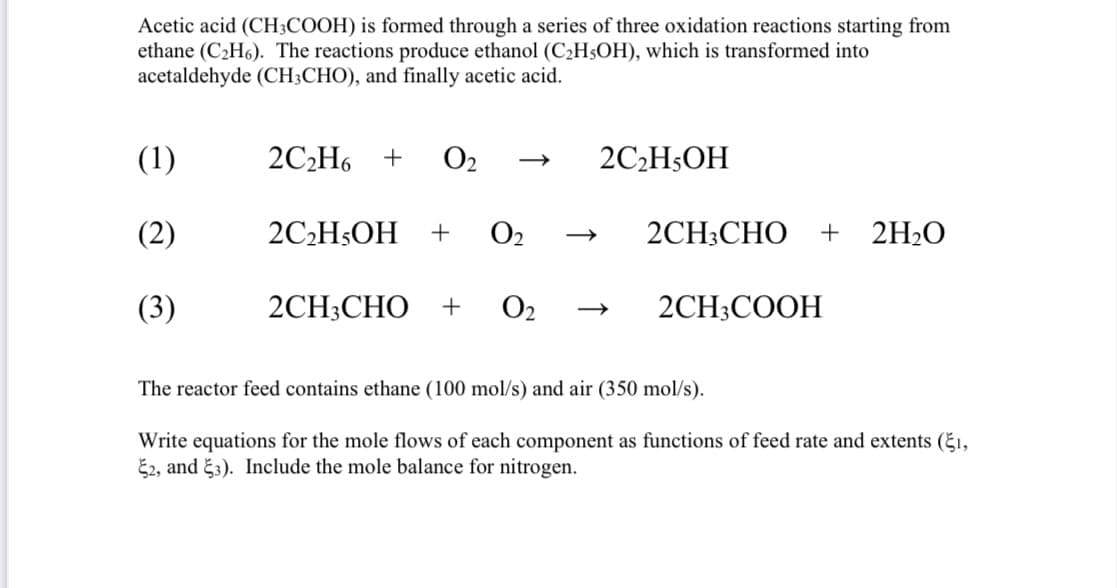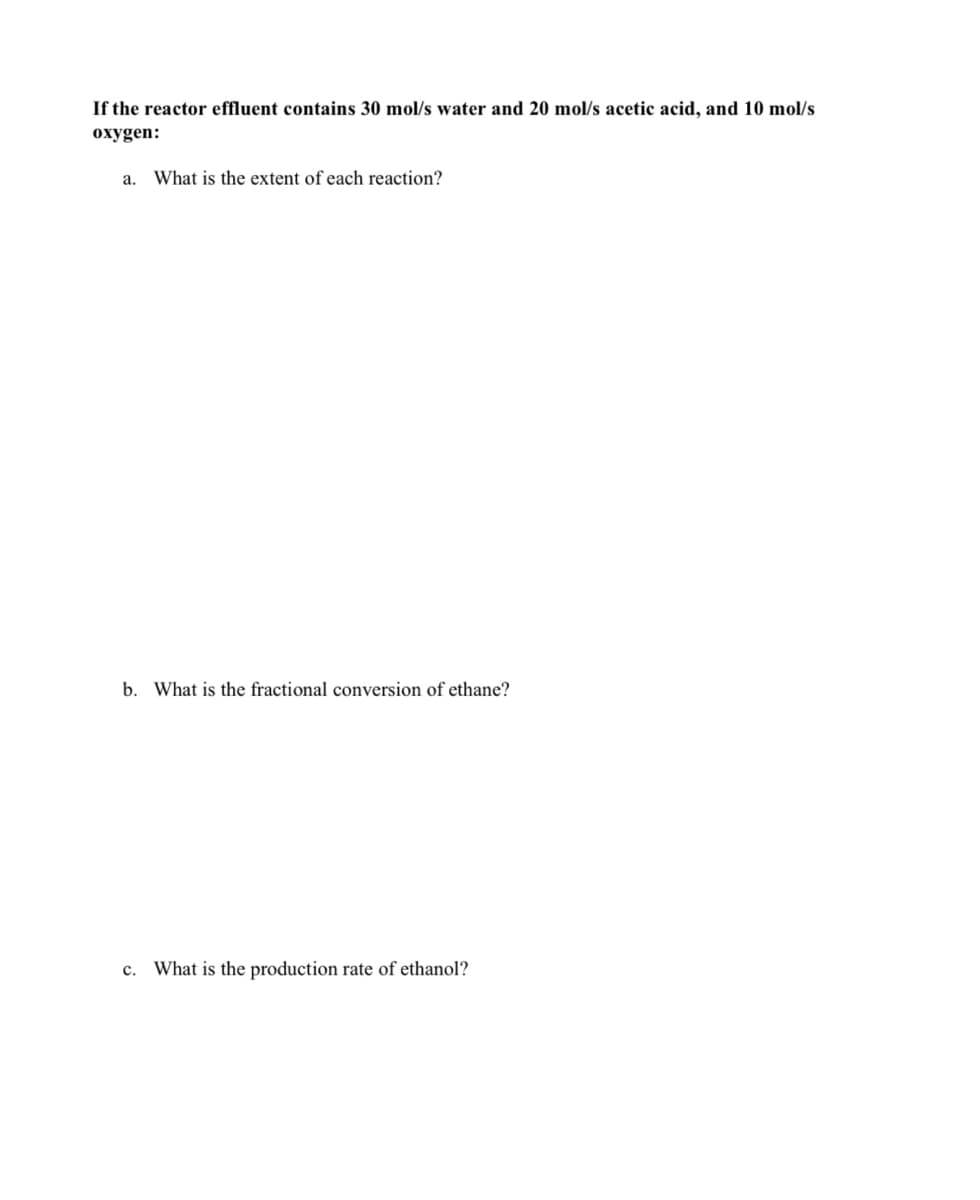Acetic acid DOH) is formed through a series of three oxidation reactions starting from ethane (C₂H6). The reactions produce ethanol (C₂H5OH), which is transformed into acetaldehyde (CH3CHO), and finally acetic acid. (1) (2) (3) 2C₂H6 + 0₂ 2C₂H5OH + 0₂ 2CH3CHO + +0₂ 2C₂H5OH 2CH3CHO + 2CH3COOH 2H₂O The reactor feed contains ethane (100 mol/s) and air (350 mol/s). Write equations for the mole flows of each component as functions of feed rate and extents (1, E2, and 3). Include the mole balance for nitrogen.
Acetic acid DOH) is formed through a series of three oxidation reactions starting from ethane (C₂H6). The reactions produce ethanol (C₂H5OH), which is transformed into acetaldehyde (CH3CHO), and finally acetic acid. (1) (2) (3) 2C₂H6 + 0₂ 2C₂H5OH + 0₂ 2CH3CHO + +0₂ 2C₂H5OH 2CH3CHO + 2CH3COOH 2H₂O The reactor feed contains ethane (100 mol/s) and air (350 mol/s). Write equations for the mole flows of each component as functions of feed rate and extents (1, E2, and 3). Include the mole balance for nitrogen.
Introduction to Chemical Engineering Thermodynamics
8th Edition
ISBN:9781259696527
Author:J.M. Smith Termodinamica en ingenieria quimica, Hendrick C Van Ness, Michael Abbott, Mark Swihart
Publisher:J.M. Smith Termodinamica en ingenieria quimica, Hendrick C Van Ness, Michael Abbott, Mark Swihart
Chapter1: Introduction
Section: Chapter Questions
Problem 1.1P
Related questions
Question

Transcribed Image Text:Acetic acid (CH3COOH) is formed through a series of three oxidation reactions starting from
ethane (C₂H6). The reactions produce ethanol (C₂H5OH), which is transformed into
acetaldehyde (CH3CHO), and finally acetic acid.
(1)
(2)
(3)
2C₂H6 + 0₂
2C₂H5OH
+ 0₂
2CH3CHO + 0₂
2C₂H5OH
2CH3CHO + 2H₂O
2CH3COOH
The reactor feed contains ethane (100 mol/s) and air (350 mol/s).
Write equations for the mole flows of each component as functions of feed rate and extents (1,
2, and 3). Include the mole balance for nitrogen.

Transcribed Image Text:If the reactor effluent contains 30 mol/s water and 20 mol/s acetic acid, and 10 mol/s
oxygen:
a. What is the extent of each reaction?
b. What is the fractional conversion of ethane?
c. What is the production rate of ethanol?
Expert Solution
This question has been solved!
Explore an expertly crafted, step-by-step solution for a thorough understanding of key concepts.
This is a popular solution!
Trending now
This is a popular solution!
Step by step
Solved in 2 steps

Recommended textbooks for you

Introduction to Chemical Engineering Thermodynami…
Chemical Engineering
ISBN:
9781259696527
Author:
J.M. Smith Termodinamica en ingenieria quimica, Hendrick C Van Ness, Michael Abbott, Mark Swihart
Publisher:
McGraw-Hill Education

Elementary Principles of Chemical Processes, Bind…
Chemical Engineering
ISBN:
9781118431221
Author:
Richard M. Felder, Ronald W. Rousseau, Lisa G. Bullard
Publisher:
WILEY

Elements of Chemical Reaction Engineering (5th Ed…
Chemical Engineering
ISBN:
9780133887518
Author:
H. Scott Fogler
Publisher:
Prentice Hall

Introduction to Chemical Engineering Thermodynami…
Chemical Engineering
ISBN:
9781259696527
Author:
J.M. Smith Termodinamica en ingenieria quimica, Hendrick C Van Ness, Michael Abbott, Mark Swihart
Publisher:
McGraw-Hill Education

Elementary Principles of Chemical Processes, Bind…
Chemical Engineering
ISBN:
9781118431221
Author:
Richard M. Felder, Ronald W. Rousseau, Lisa G. Bullard
Publisher:
WILEY

Elements of Chemical Reaction Engineering (5th Ed…
Chemical Engineering
ISBN:
9780133887518
Author:
H. Scott Fogler
Publisher:
Prentice Hall


Industrial Plastics: Theory and Applications
Chemical Engineering
ISBN:
9781285061238
Author:
Lokensgard, Erik
Publisher:
Delmar Cengage Learning

Unit Operations of Chemical Engineering
Chemical Engineering
ISBN:
9780072848236
Author:
Warren McCabe, Julian C. Smith, Peter Harriott
Publisher:
McGraw-Hill Companies, The